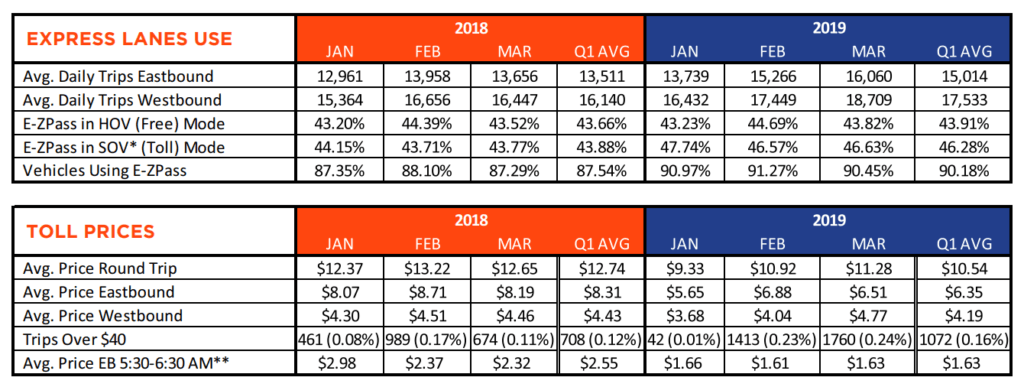Interstate 66 traffic inside the Capital Beltway slowed in the first three months of 2019 compared with last year, as the Virginia Department of Transportation significantly lowered tolls for solo drivers.
Average toll prices paid toward D.C. in the morning fell from $8.31 in the first quarter of 2018 to $6.35 in 2019. Average toll prices paid toward the Beltway in the afternoon dropped from $4.43 in January, February and March of 2018, to $4.19 in 2019.
The number of trips that cost over $40 increased though, from 708 in 2018 to 1,072 in the first three months of 2019.
The changes appear to have played a role in increasing the total number of car trips on the road compared with the first three months of 2018, shortly after tolling and expanded HOV hours began.
Morning trips rose 11.1% from the initial ramp-up period to 15,014 per day this winter, and afternoon trips rose 8.6% to 17,533.
Read more
- How much drivers saved from free I-66 tolls
- First potential opening date set for Silver Line into Loudoun County
- I-66 tolls turn 1 year old — Are they working?
More than half of the drivers using the road each day are paying a toll either with an E-ZPass or because they are among the 1 in 10 users who do not have a transponder, so they get a bill in the mail.
The proportion of cars riding free with an E-ZPass Flex in HOV mode — to indicate there are at least two people in the car — is relatively steady, between 43% and 44%.

In January, February and March of 2019, average morning travel speeds toward the District were slower between 7 and 9 a.m. than they were in the same month in 2017, before tolls started.
Overall, in the new four-hour morning rush though, speeds are faster on average, because there is no longer a major backup between 6 and 7 a.m. linked to drivers trying to commute before the HOV rules applied.
Including the major traffic drop-off in January during the government shutdown that made for faster commutes with lower tolls, average eastbound morning travel speeds this winter hit 45.6 mph, according to a new VDOT report.
The slowest traffic — below 40 mph — is between about 8 and 9:15 a.m.
Drivers who complained about toll rates had asked VDOT to lower the target speed to around 45 mph in order to reduce tolling spikes that are aimed at keeping solo drivers off the road to allow carpoolers and buses to keep moving.
In 2018, average speeds were 51.1 mph between 5:30 and 9:30 a.m. In 2019, the average was 41.8 mph over the entire four-hour period, but HOV rules applied only from 6:30 to 9 a.m. and were inconsistently enforced.
In the afternoon, average westbound speeds dipped slightly this winter compared with the same period in 2018. Speeds between 4:30 and 6:30 p.m. are largely the same as they were before tolling and expanded HOV hours, but traffic continued to be faster than 2017 in the periods that used to have no HOV restrictions.
The report shows average speeds along U.S. Route 50 and Virginia routes 29 and 7 in the I-66 corridor ticked up slightly this winter. But travel times on the George Washington Parkway in both directions declined, compared with last year. In the morning, parkway speeds also declined compared with 2017, from 35.8 mph to 34.3 mph.
Speed and travel time data in the report is based on the middle of the week — Tuesday, Wednesday and Thursday — because there is significantly less traffic on Mondays and Fridays due to telework, vacations and other differences. Average tolls paid though include the entire week of rush hours.
Tolls are typically higher Tuesday, Wednesday and Thursday.







